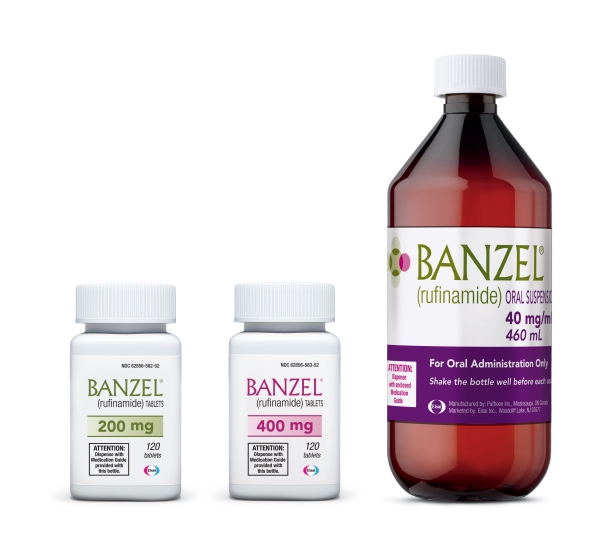
Banzel (Rufinamide) was developed in 2004 by Novartis Pharma. It is being manufactured by Eisai in Europe. It is indicated for the treatment of epileptic seizures which are associated with Lennox-Gastaut syndrome (LGS) (L~G症候群,雷葛氏症候群) in children and adults.
Eisai submitted a New Drug Application (NDA) for Banzel to the FDA in September 2005. The drug was approved by the FDA for the treatment of severe epilepsy disorder in November 2008. The drug also obtained approval for the 40mg/ml oral suspension in March 2011.
Eisai filed the Marketing Authorization Application (MAA) to the European Medicines Agency (EMA) in March 2005. The EMA approved the drug for the treatment of LGS patients in January 2007.
Banzel was approved by Health Canada for the treatment of adults and children having epilepsy associated with LGS in June 2011. The drug is being marketed under the trade name BANZEL.
Lennox-Gastaut syndrome
Lennox-Gastaut syndrome is usually caused by brain malformations, severe head injury, central nervous system infection and inherited degenerative or metabolic conditions. It is a type of epilepsy that causes seizures of various types. The seizures are uncontrollable and affect the quality of life of the patient as well as the family members.
LGS usually occurs in children of school-going ages who are already suffering from organic brain disorders such as encephalopathy. It may also cause delayed intellectual development and personality disorders.
The most common types of seizures found in LGS patients are tonic (muscle stiffening), atonic (sudden loss of muscle tone / drop attacks) and absence (staring) seizures.
Tonic-clonic and myo clonic are the other types of seizures found to occur in LGS patients. Tonic and atonic seizures cause frequent fall of the patient.
Banzel - drug mechanism of action
Banzel is a triazole derivative whose mechanism of action is unknown. The main ingredient of the drug is an anti-epileptic agent called Rufinamide. Rufinamide is believed to modulate the activity of sodium channels, especially the prolongation of the inactive state of the channel.
Pre-clinical trials of Novartis Pharma's drug
Pre-clinical studies were conducted in mice, rats and rhesus monkey. Rufinamide was found to be more effective in tonic-clonic induced mice and rats compared to chemically induced epileptic seizures.
The seizure frequency was found to be reduced in rufinamide treated rhesus monkeys with partial epileptic seizures. Rufinamide was well tolerated in the animal studies and the results varied in each of the species.
Clinical trials of banzel (rufinamide)
A clinical trial was conducted to evaluate the safety and efficacy of banzel in 138 patients aged from four to 37. The trial was conducted for a period of four weeks followed by a ten-week maintenance period. The patients were administered either rufinamide or were given a placebo. Reduction in frequency of total seizures and reduced tonic-atonic seizures were observed. The primary end point was met.
A Phase III trial was initiated in July 2011 to evaluate the safety, efficacy and pharmacokinetics of the drug in paediatric patients with Lennox-Gastaut syndrome. Around 75 patients aged between one and four have been enrolled. The patients will be administered either 45gm of banzel or any other approved antiepileptic drug.
The primary endpoint will be the change in child behaviour checklist (CBCL) and the change in the Total Problems Score. The trial is expected to be completed by August 2015.
In June 2010 around 50 LGS patients aged from four to 30 were enrolled for a double-blind Phase III study. The trial proved that banzel was superior when compared to a placebo. The patients were administered either 45mg/kg twice daily or were orally given a placebo twice daily for a period of 12 weeks. The trial was completed in August 2011.
A 36 month long term observational study was conducted to evaluate the safety and efficacy of rufinamide in LGS patients. Around 124 patients were enrolled, of which more than 70% were aged between four and 16. Around 40% of the patients discontinued the trial due to lower efficacy, while 34% of the patients completed the trial. Adverse reactions were found in 17 patients.
A Phase IV study was initiated to determine the effect of the drug on nerve excitability, hyperalgesia, allodynia and flare reaction, and was compared to that of a placebo.
The trial that began in October 2010 enrolled 24 healthy people aged between 18 to 65 years. The entire trial is expected to be completed by April 2012.





 留言列表
留言列表
 線上藥物查詢
線上藥物查詢 